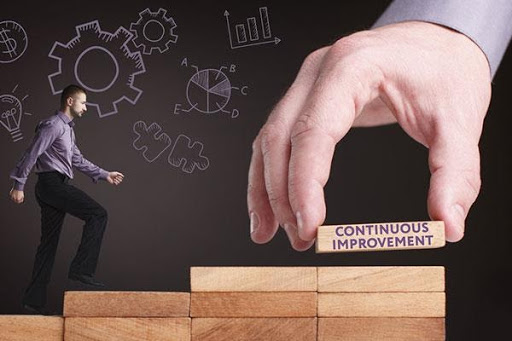Continuous Improvement: Essential to Leveraging Agile Portfolio Management

As the world moves on from the traditional ways, a lot has been written about Agile Portfolio Management. In the past decade, many organizations have adopted this efficient approach to portfolio management, yet a few fundamental problems restrict it from becoming the dominant approach.
Agile Portfolio Management ensures that your company provides the best value to clients for the investment. In its simplest form, it is all about enabling a business to respond rapidly to the changing market condition and improving continuously.
Continuous improvement is a method which makes sure that your processes, practices, and methods are efficient and effective by continuously updating systems according to new and efficient technologies. Typically, it is also the process of analyzing the efficiency of business workflows.
With regard to agile portfolio management, continuous improvement is one of the core principles of the agile manifesto. So, let's try to understand why it is essential to leverage agile management.
Why Continuous Improvement?

The first thing we need to understand is why we need continuous improvement. There are several reasons why:
1. Streamlined Workflow
Continuous Improvement is a lean technique that helps project managers streamline workflows. To constantly improve your processes and methods is also one of the most efficient ways to reduce your business's operating overhead. Lean Improvement enables efficient workflow that allows you to reduce wasted effort and saves time and money.
2. Reduced Cost of Project
Through forecasting software, a project manager can reduce the project cost and prevent going over budget. Project Managers can also estimate whether the project constraints will be broken in any way and how it can affect the overall effectiveness of the project.
3. Increased Knowledge Sharing
Agile teams usually have high collaboration work environments that enable knowledge sharing among team members. It is one of the goals of continuous improvement as well to share the skills and knowledge of employees outside their immediate team.
4. Increased Opportunity for Improvement
One of the challenges with Kaizen or continuously making small improvements is that it does not lead to a quantum leap in the process. For example, a scrum team may not be able to identify the strategy of continuous improvement, which could then lead to the radical process of improvement and move towards the continuous delivery lifecycle.
The Process

So, how do you practice continuous improvement? The key is the process, so let's break down the practices for you.
1. Mindset is the Key
The world is facing a huge wave of digital transformation right now. With this changing environment, management must be fully committed to enhancing team efficiencies. It is the responsibility of the managers to promote a company culture that is open to change. That is the first step and also a crucial part of the digital transformation initiative.
However, involving the entire organization in building a new mindset can be a real challenge for management. A part of continuous improvement is to create a culture that is more focused on quality, collaboration, and delivering the right products at the right time.
2. How to Deliver Value?
A phrase that agile trainers often use, delivering value to clients is the utmost priority of companies at the end of the day. It means commitment and delivering promised products and services to consumers. The ideal scenario to deliver value is to start from a small change first and then move on to the next step.
Agile practices often rely on the efforts of employees to own their tasks and interactions during an iteration. They also expect the speed to improve with each iteration as well. For each task to be done, the team needs space for Continuous improvement, which not only reduces burnout but also increases better performance.
3. Share Knowledge
Agile teams share knowledge with each other, which leads to excellence among the team. Teams learn from each other, which saves resources and increases organizational productivity. An agile team where people focus their efforts on improving their agile practices continuously and share that knowledge with the team as well most likely find their path towards excellence.
Technical excellence does not only mean improving technical skills, but it is also much broader, improving soft skills, self-improvement practices, and much more. Furthermore, it also means the support and mentoring from experienced individuals that enable the team to grow and achieve a better mindset.
4. Reflect, Review & Evaluate
Another important practice for Continuous Improvement is your communication skills, digital marketing skills, and team practices. Emotional Intelligence is one of the most crucial skills for an agile team as it states how you contribute to the growth and development of others around you.
Agile is built on regularly reflecting on your work, identifying improvements, and improving them. It also means planning and estimating accurately and taking a more measurable approach to delivering the product. As the agile project develops, it is also crucial to set realistic expectations and preventing the team from taking tasks more than what is possible.
5. Efficiency and Quality
Reviewing what you have delivered is the best way to strive to do everything. If you are giving an efficient service to your customer along with a high-quality product, the customer will see the improvements you are making in the project. Moreover, the customer also benefits from an accurate estimation of the work based on new information collected and, in turn, can give the estimates to the stakeholders throughout the project.
6. Knowledge for Future
Continuous improvement is not possible if you are not reviewing the project regularly and using the feedback and new knowledge to enhance your product. Through sprints and agile retrospectives, you can continuously look for ways to improve in the future and implement change.
Conclusion
In the end, remember, processes and tools are abundant, but they are not enough to deliver value to your clients. Creating an impact by making timely decisions and constantly increasing your capacity to produce value is what makes the difference.
What do you think about agile practices in the digital era? Don't forget to share your views with us!

